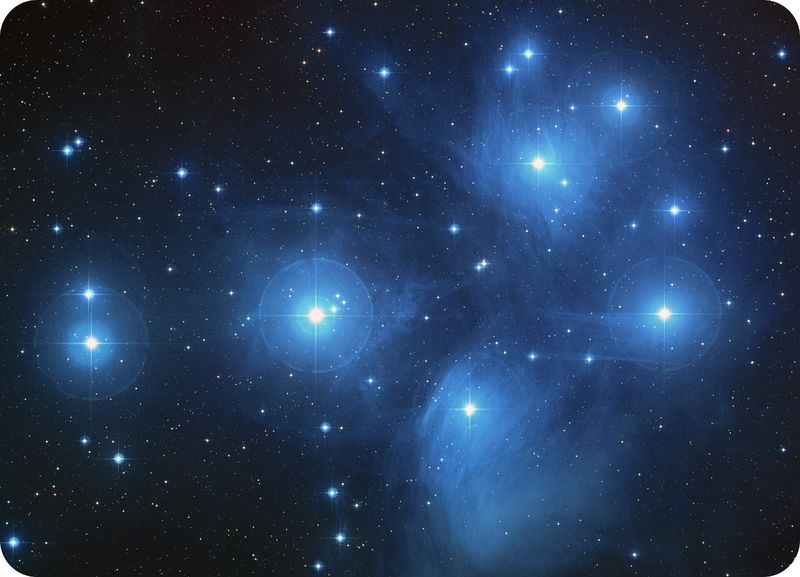23.11: Star Clusters
- Page ID
- 6252
\( \newcommand{\vecs}[1]{\overset { \scriptstyle \rightharpoonup} {\mathbf{#1}} } \)
\( \newcommand{\vecd}[1]{\overset{-\!-\!\rightharpoonup}{\vphantom{a}\smash {#1}}} \)
\( \newcommand{\dsum}{\displaystyle\sum\limits} \)
\( \newcommand{\dint}{\displaystyle\int\limits} \)
\( \newcommand{\dlim}{\displaystyle\lim\limits} \)
\( \newcommand{\id}{\mathrm{id}}\) \( \newcommand{\Span}{\mathrm{span}}\)
( \newcommand{\kernel}{\mathrm{null}\,}\) \( \newcommand{\range}{\mathrm{range}\,}\)
\( \newcommand{\RealPart}{\mathrm{Re}}\) \( \newcommand{\ImaginaryPart}{\mathrm{Im}}\)
\( \newcommand{\Argument}{\mathrm{Arg}}\) \( \newcommand{\norm}[1]{\| #1 \|}\)
\( \newcommand{\inner}[2]{\langle #1, #2 \rangle}\)
\( \newcommand{\Span}{\mathrm{span}}\)
\( \newcommand{\id}{\mathrm{id}}\)
\( \newcommand{\Span}{\mathrm{span}}\)
\( \newcommand{\kernel}{\mathrm{null}\,}\)
\( \newcommand{\range}{\mathrm{range}\,}\)
\( \newcommand{\RealPart}{\mathrm{Re}}\)
\( \newcommand{\ImaginaryPart}{\mathrm{Im}}\)
\( \newcommand{\Argument}{\mathrm{Arg}}\)
\( \newcommand{\norm}[1]{\| #1 \|}\)
\( \newcommand{\inner}[2]{\langle #1, #2 \rangle}\)
\( \newcommand{\Span}{\mathrm{span}}\) \( \newcommand{\AA}{\unicode[.8,0]{x212B}}\)
\( \newcommand{\vectorA}[1]{\vec{#1}} % arrow\)
\( \newcommand{\vectorAt}[1]{\vec{\text{#1}}} % arrow\)
\( \newcommand{\vectorB}[1]{\overset { \scriptstyle \rightharpoonup} {\mathbf{#1}} } \)
\( \newcommand{\vectorC}[1]{\textbf{#1}} \)
\( \newcommand{\vectorD}[1]{\overrightarrow{#1}} \)
\( \newcommand{\vectorDt}[1]{\overrightarrow{\text{#1}}} \)
\( \newcommand{\vectE}[1]{\overset{-\!-\!\rightharpoonup}{\vphantom{a}\smash{\mathbf {#1}}}} \)
\( \newcommand{\vecs}[1]{\overset { \scriptstyle \rightharpoonup} {\mathbf{#1}} } \)
\( \newcommand{\vecd}[1]{\overset{-\!-\!\rightharpoonup}{\vphantom{a}\smash {#1}}} \)
\(\newcommand{\avec}{\mathbf a}\) \(\newcommand{\bvec}{\mathbf b}\) \(\newcommand{\cvec}{\mathbf c}\) \(\newcommand{\dvec}{\mathbf d}\) \(\newcommand{\dtil}{\widetilde{\mathbf d}}\) \(\newcommand{\evec}{\mathbf e}\) \(\newcommand{\fvec}{\mathbf f}\) \(\newcommand{\nvec}{\mathbf n}\) \(\newcommand{\pvec}{\mathbf p}\) \(\newcommand{\qvec}{\mathbf q}\) \(\newcommand{\svec}{\mathbf s}\) \(\newcommand{\tvec}{\mathbf t}\) \(\newcommand{\uvec}{\mathbf u}\) \(\newcommand{\vvec}{\mathbf v}\) \(\newcommand{\wvec}{\mathbf w}\) \(\newcommand{\xvec}{\mathbf x}\) \(\newcommand{\yvec}{\mathbf y}\) \(\newcommand{\zvec}{\mathbf z}\) \(\newcommand{\rvec}{\mathbf r}\) \(\newcommand{\mvec}{\mathbf m}\) \(\newcommand{\zerovec}{\mathbf 0}\) \(\newcommand{\onevec}{\mathbf 1}\) \(\newcommand{\real}{\mathbb R}\) \(\newcommand{\twovec}[2]{\left[\begin{array}{r}#1 \\ #2 \end{array}\right]}\) \(\newcommand{\ctwovec}[2]{\left[\begin{array}{c}#1 \\ #2 \end{array}\right]}\) \(\newcommand{\threevec}[3]{\left[\begin{array}{r}#1 \\ #2 \\ #3 \end{array}\right]}\) \(\newcommand{\cthreevec}[3]{\left[\begin{array}{c}#1 \\ #2 \\ #3 \end{array}\right]}\) \(\newcommand{\fourvec}[4]{\left[\begin{array}{r}#1 \\ #2 \\ #3 \\ #4 \end{array}\right]}\) \(\newcommand{\cfourvec}[4]{\left[\begin{array}{c}#1 \\ #2 \\ #3 \\ #4 \end{array}\right]}\) \(\newcommand{\fivevec}[5]{\left[\begin{array}{r}#1 \\ #2 \\ #3 \\ #4 \\ #5 \\ \end{array}\right]}\) \(\newcommand{\cfivevec}[5]{\left[\begin{array}{c}#1 \\ #2 \\ #3 \\ #4 \\ #5 \\ \end{array}\right]}\) \(\newcommand{\mattwo}[4]{\left[\begin{array}{rr}#1 \amp #2 \\ #3 \amp #4 \\ \end{array}\right]}\) \(\newcommand{\laspan}[1]{\text{Span}\{#1\}}\) \(\newcommand{\bcal}{\cal B}\) \(\newcommand{\ccal}{\cal C}\) \(\newcommand{\scal}{\cal S}\) \(\newcommand{\wcal}{\cal W}\) \(\newcommand{\ecal}{\cal E}\) \(\newcommand{\coords}[2]{\left\{#1\right\}_{#2}}\) \(\newcommand{\gray}[1]{\color{gray}{#1}}\) \(\newcommand{\lgray}[1]{\color{lightgray}{#1}}\) \(\newcommand{\rank}{\operatorname{rank}}\) \(\newcommand{\row}{\text{Row}}\) \(\newcommand{\col}{\text{Col}}\) \(\renewcommand{\row}{\text{Row}}\) \(\newcommand{\nul}{\text{Nul}}\) \(\newcommand{\var}{\text{Var}}\) \(\newcommand{\corr}{\text{corr}}\) \(\newcommand{\len}[1]{\left|#1\right|}\) \(\newcommand{\bbar}{\overline{\bvec}}\) \(\newcommand{\bhat}{\widehat{\bvec}}\) \(\newcommand{\bperp}{\bvec^\perp}\) \(\newcommand{\xhat}{\widehat{\xvec}}\) \(\newcommand{\vhat}{\widehat{\vvec}}\) \(\newcommand{\uhat}{\widehat{\uvec}}\) \(\newcommand{\what}{\widehat{\wvec}}\) \(\newcommand{\Sighat}{\widehat{\Sigma}}\) \(\newcommand{\lt}{<}\) \(\newcommand{\gt}{>}\) \(\newcommand{\amp}{&}\) \(\definecolor{fillinmathshade}{gray}{0.9}\)Can you see a star cluster in the night sky?
The Pleiades are also called the seven sisters. Seven of the stars in this cluster are visible in the night sky with the naked eye. The Pleiades are easy to spot. They are bright and very close to each other.
Star Systems
Our solar system has only one star. But many stars are in star systems of two or more stars. Two stars that orbit each other are called a binary star system. If more than two stars orbit each other, it is called a multiple star system. Pictured below are two binary star systems orbiting each other (Figure below). This creates an unusual quadruple star system. The distance separating the two pairs is about the same as the distance from our Sun to Pluto.
This is an artist’s depiction of HD 98800. This is a quadruple star system made of two binary star systems.
Star Clusters
Star clusters are small groups of stars. A star cluster is smaller than a galaxy. There are two main types, open clusters and globular clusters. Both types are held together by gravity.
Open Clusters
Open clusters are groups of up to a few thousand stars. The Jewel Box (Figure below), is an open cluster. Open clusters tend to be blue in color. They often contain glowing gas and dust. The stars in an open cluster are young stars that all formed from the same nebula.
These hot blue stars are in an open cluster known as the Jewel Box. The red star is a young red supergiant.
Globular Clusters
Globular clusters (Figure below) are groups of tens to hundreds of thousands of stars. Gravity holds these stars tightly together. Globular clusters have a definite, spherical shape. They contain mostly old, reddish stars. Near the center of a globular cluster, the stars are closer together. The heart of the globular cluster M13 has hundreds of thousands of stars. M13 is 145 light years in diameter. The cluster contains red and blue giant stars.
The globular cluster, M13, contains red and blue giant stars.
Summary
- Two or more stars may orbit each other in a star system.
- A group of stars, smaller than a galaxy, is a star cluster.
- The two main types of star clusters are open clusters and globular clusters.
Review
- What are the characteristics of a star system?
- What is the difference between an open cluster and a globular cluster?
- How do star clusters stay together?
Explore More
Use the resource below to answer the questions that follow.
- What is NGC 3603 and what does it contain?
- What is happening in the star cluster? Where is it located?
- What is the nebula?
- When were the stars in this star cluster formed?
- What type of stars are in the star cluster?
- What is the significance of the dark regions in the nebula?
- What stage of life is the blue supergiant in? What will happen to it next?
- Why is the fate of the blue supergiant so significant?
References
| Image | Reference | Attributions |
|---|---|---|
 |
[Figure 1] |
Credit: Courtesy of ESA/Hubble and NASA;Courtesy of NASA Source: commons.wikimedia.org/wiki/File:Heart_of_M13_Hercules_Globular_Cluster.jpg ; commons.wikimedia.org/wiki/File:Beit_Alpha.jpg License: Public Domain |
 |
[Figure 2] |
Credit: Courtesy of NASA/JPL-Caltech/T. Pyle (SSC);By Maximilien Brice - https://cds.cern.ch/record/1211045, CC BY-SA 4.0, commons.wikimedia.org/w/inde...44864;Courtesy of NASA Source: commons.wikimedia.org/wiki/File:HD_98800.jpg ; By Maximilien Brice - https://cds.cern.ch/record/1211045 ; CC BY-SA 4.0 ; commons.wikimedia.org/w/index.php?curid=47844864 ; commons.wikimedia.org/wiki/File:Beit_Alpha.jpg License: Public Domain; CC BY-NC 3.0 |
 |
[Figure 3] |
Credit: ESO/Y. Beletsky;By Maximilien Brice - https://cds.cern.ch/record/1211045, CC BY-SA 4.0, commons.wikimedia.org/w/inde...44864;Courtesy of NASA Source: commons.wikimedia.org/wiki/File:A_Snapshot_of_the_Jewel_Box_cluster_with_the_ESO_VLT.jpg ; By Maximilien Brice - https://cds.cern.ch/record/1211045 ; CC BY-SA 4.0 ; https://commons.wikimedia.org/w/index.php?curid=47844864 ; commons.wikimedia.org/wiki/File:Beit_Alpha.jpg License: CC BY 3.0; CC BY-NC 3.0; Public Domain |
 |
[Figure 4] |
Credit: Courtesy of ESA/Hubble and NASA Source: commons.wikimedia.org/wiki/File:Heart_of_M13_Hercules_Globular_Cluster.jpg License: Public Domain |




